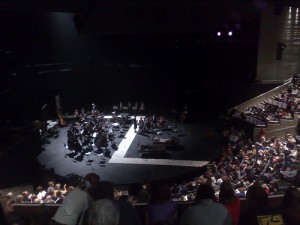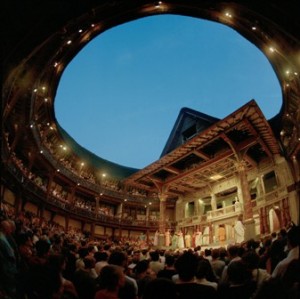“Doctors, patients, poets, Christians and cannibals” are what the program for “Bedlam”, Nell Leyshon’s new play, promises. The first female-written play ever to be produced for Shakespeare’s Globe Theatre focuses on Bedlam Mad Hospital, an institution whose practices are drenched as much in sex, exploitation and alcohol as in science. Visionary? Maybe. Crazy? Absolutely.
A “Bedlam” of vision
September 9th, 2010 · 3 Comments
Tags: 2010 Patrick
All the World’s a Stage
September 14th, 2009 · 1 Comment
During our time in London we’ve had the opportunity to attend many theatre performances. As I chose to see the optional plays as well, the total count comes to 6: Troilus and Cressida, Arcadia, All’s Well That Ends Well, As You Like It, Pitmen Painters, and Blood Brothers. Although I could probably write an entire paper on each of the plays, I would actually like to discuss the three Shakespeare plays I saw, especially the differences in the theatres where they were performed: The National Theatre and Shakespeare’s Globe.
The first Shakespeare performance we saw was Troilus and Cressida. To be honest, I wasn’t all that excited about the story when I read the play over the summer as it was not as engaging as his more famous plays I was familiar with already. Therefore, I wasn’t too excited to stand for three hours through a play that I thought would be rather boring. The experience at the Globe was exactly opposite of what I was expecting, though. I loved being so close to the actors that I could see every minute facial expression. Seeing the live performance was also much more entertaining than reading it and I learned that you really must see a Shakespeare play to truly appreciate all of the subtleties that are often lost in the text.
All’s Well That Ends Well was performed in the Olivier Theatre of The National Theatre. The Olivier seats about 1200 people and is styled after a Greek amphitheatre. During our tour of the National Theatre, we learned that this semi-circular shape allows the actors to maintain a connection with the entirety of the audience. While this may be a better set-up than the raised stage in the front, especially for Shakespeare, one still has the experience of the lights going down and watching the events unfold from afar. I definitely did not feel a personal connection with the actors and at many points I could barely see their faces or expressions. Overall, I felt kind of far away and uninvolved. I found the play to be mediocre. It had some funny parts, but none were all that “laugh-out-loud.” I don’t necessarily think that this play was any worse than Shakespeare’s other plays as it is such a well-known title; I simply think I felt disengaged with the performance.

The Olivier
As You Like It proved to me my love for Shakespeare’s Globe. This performance was so incredibly interactive I enjoyed every second of it. At first, I regretted opting for the groundling ticket as I had just come from giving my walking tour, but I later came to realize it was the best place to be for the performance. During the play, the actors walked through the audience and even acted out the wrestling scene in the front of the groundling section. There were numerous points during the show when the actors made side comments about the audience that could not be heard from the seats farther away.

The Globe
The style of the stage at the Globe is the way Shakespeare intended his works to be performed. We’ve heard some criticism about the Globe, especially from A.N. Wilson, because of its links to Disney, its appeal to tourists, etc., etc. I don’t necessarily disagree with such observations, but I do think the Globe deserves some justification. There are few venues where one can see Shakespeare’s plays performed in this manner, and frankly I feel this is the best way to see these performances.
